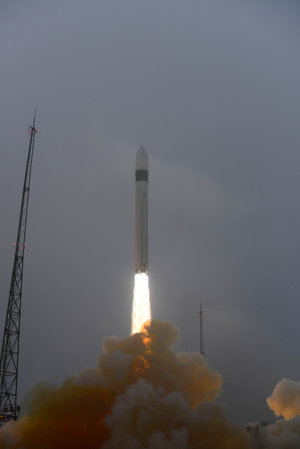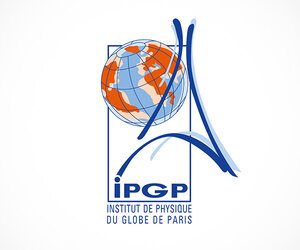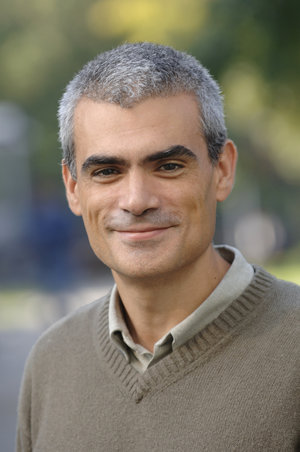Gauthier Hulot: Lead Proposer
Gauthier Hulot is one of three scientists leading a large team that proposed the Swarm mission to ESA. With expertise in Earth’s magnetic field, Gauthier talks about the possibility of magnetic reversal and how Swarm will contribute to our understanding of this invisible force.

Gauthier, a French national, started working with ESA soon after the selection of Swarm in 2002, both as a member of the Swarm Mission Advisory Group, contributing to the detailed definition of the mission’s requirements, and as lead scientist of the Absolute Scalar Magnetometers (ASMs).
Gauthier, presently a senior CNRS scientist, spent most of his career within the Institut de Physique du Globe de Paris (IPGP), where he currently heads the Geomagnetism Group. He was part-time Professor at France’s École Polytechnique for 12 years, and spent one year at NASA’s Goddard Space Flight Center. His research focuses on the investigation of the main magnetic field produced within Earth’s core, and deals with the issue of converting all types of data (satellite, historical, archaeomagnetic and paleomagnetic) into information about the past and present behavior of the main magnetic field, which he then interprets in terms of core dynamical processes.
Gauthier is a former student of the Ecole Normale Supérieure in Paris. He earned a MSc in Quantum Physics at the Université Pierre et Marie Curie and a PhD in Geophysics at the Université Paris Diderot, both in Paris.
ESA: How can Swarm contribute to the question of whether we are on the verge of a magnetic reversal?
Gauthier Hulot
Swarm will allow us to image the main field produced by the geodynamo in even more detail than previously possible. These high-resolution images will complement less-resolved images already documenting the past behaviour of the field, thanks to previous satellite missions, historical records and even fossil records (using the magnetic fossil record of potteries, bricks and rocks). Together, these images will be used to further decipher the mechanisms underlying the recent evolution of the magnetic field. They will also provide us with the information needed to forecast its future evolution, up to perhaps a few decades, using numerical dynamo data assimilation techniques. The extent to which the region with the weakest magnetic field on Earth (the so-called South Atlantic Anomaly) may further weaken will be assessed. Whether this indicates that we are on the verge of a magnetic reversal, however, is beyond what one may expect to learn from Swarm. Even if Swarm eventually shows that the field will further decrease over the next decades, this would not necessarily imply that the trend would last long enough to possibly lead to a reversal, a couple of thousand years from now.
ESA: What are the consequences of the present weakening of Earth’s magnetic field?
Gauthier Hulot
Earth’s magnetic field forms a shield against the solar wind and cosmic rays, protecting a wide region around the planet, known as the magnetosphere. This shield, however, is not fully ‘particle-proof’. Some particles do manage to enter the magnetosphere and interact with the atmosphere, often producing even more particles. These dangerous particles criss-cross the magnetosphere in ‘radiation belts’ that circle Earth. In regions where the field is weaker, such as over the South Atlantic anomaly, they get closer to the atmosphere, endangering near space activity and satellite systems. The present weakening of the magnetic field increases this danger. Another source of concern is linked to the electrical currents produced by the deflection of the incoming particles as they meet the magnetosphere. These currents produce strong magnetic perturbations, particularly at high latitudes. They can become very intense during solar storms, when the solar wind is much stronger, and cause major disruptions in ground electrical systems. Unfortunately, as the field globally decreases, the magnetosphere shrinks, and these electrical currents get closer to Earth, increasing the risk of such disruptions. In short, as the magnetic field weakens, the consequences of solar storms, both in terms of exposure to energetic particles and risk of major electrical disruptions, become more serious.
ESA: How will the mission improve our understanding of Earth’s crust, mantle and core?
Gauthier Hulot
In several ways. First, it will provide the means to better distinguish the magnetic fields produced by sources within the solid Earth, the ionosphere and the magnetosphere. The constellation design of Swarm will make this ‘source separation’ much more efficient than previously possible. Measuring field gradients using the two satellites orbiting close to each other will help increase the level of detail with which the ‘crustal field’ (the field due to magnetized rocks within the crust) can be imaged from space. The goal is to recover this field down to length scales of a few hundred kilometres – beyond which ground, ship and airborne surveys already provide independent information – to produce comprehensive maps of the magnetized crust. Such maps provide crucial information about the nature and dynamics of Earth’s crust. Accurately knowing this crustal field will also help increase our ability to image the time-varying main field, eventually leading to a better understanding of the geodynamo and fast core dynamics. Finally, identifying the fast changing field produced by the magnetosphere and its ‘image field’ produced by the induced electrical response of the mantle will allow the construction of 3D planetary scale images of the mantle’s electrical conductivity. Such images provide very useful information about the nature and dynamics of Earth’s mantle.
ESA: What is expected from the Absolute Scalar Magnetometers in terms of science?
Gauthier Hulot
The Absolute Scalar Magnetometers – developed by the French company CEA-Leti and provided as in-kind contributions to the Swarm mission by the French Space Agency CNES – provide extremely accurate absolute measurements of the field intensity. These data are to be used to calibrate the data from the Vector Field Magnetometers (which measure the three components of the vector field), and for science investigations. By design, indeed, and also because intensity measurements do not need any attitude reconstruction, the extremely precise ASM intensity measurements can directly be used to detect signals that cannot be otherwise detected. These data will be particularly useful for recovering the faint signal from the smallest scales of the crustal field. They may also detect local ionospheric signals that would otherwise escape notice. This possibility is to be explored during the commissioning phase, taking advantage of the fact that the ASMs can be run at 250 Hz (using a burst mode). Finally, it should also be mentioned that, in their nominal 1 Hz mode and in addition to the intensity measurements mentioned above, these ASMs also provide experimental absolute vector measurements. These additional experimental data will be analysed, but mainly for engineering and proof of concept purposes.
ESA: What is the role of IPGP in the mission?
Gauthier Hulot
IPGP plays two distinct roles, one with respect to the ASM instruments, the other with respect to the Swarm Satellite Constellation Application and Research Facility (SCARF). IPGP has a long-standing partnership with CNES and CEA-Léti. This partnership dates back to the Danish Ørsted satellite, which carries a (still operating) CEA-Léti designed Overhauser absolute magnetometer. It led IPGP to play a similar role in the Swarm mission, with CNES providing ESA with CEA-Léti designed ASMs, as in-kind contributions to the mission. IPGP is taking an active role in the commissioning of these ASM instruments, and is responsible for the scientific analysis of the experimental data (both 250 Hz burst mode intensity data and 1 Hz absolute vector data). Within the Swarm SCARF, IPGP is in charge of the production of several Level 2 data products for ESA, in partnership with the US National Oceanic and Atmospheric Administration (NOAA). Like all products from the ESA mission, these will be made freely available.



















